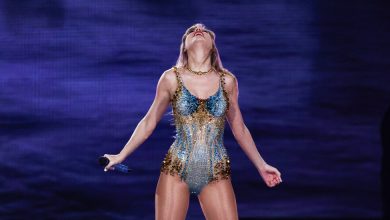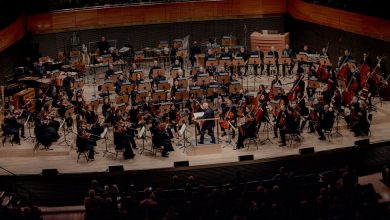Review: What if ‘Star Wars’ Really Were Japanese?

“Intellectual property” probably wasn’t a term anyone thought to apply to “Star Wars” when the first movie premiered back in May 1977. More than 40 years of films, books, television series, toys, games, trading cards and theme park rides later, it’s hard to think of George Lucas’s outer-space saga as anything but.
That might have been on the minds of the Lucasfilm executives who came up with “Star Wars: Visions,” a set of nine animated short films arriving Wednesday to Disney+. It’s the latest calculated exploitation of the brand, but it won’t wear you out. It’s low-key and small-scale, and it has an original twist: The 13-to-22-minute films were created by a variety of Japanese anime studios, making the project an instance of both cross-cultural collaboration and mutual hommage.
Animation has been a significant segment of the “Star Wars” business and story line, primarily through the “Clone Wars” films and series, including the current Disney+ show “Star Wars: The Bad Batch.” But it has never had the two-dimensional, handcrafted beauty you’ll find throughout the chapters of “Visions,” not to mention the visual variety, which makes it easy to take in the films in a single two-and-a-half-hour sitting.
The Japanese animators were given free rein to invent characters and depart from “canonical” story lines (hopefully forestalling outrage from overprotective fans). The stand-alone films introduce a raft of new heroes, though at least one incorporates some familiar characters: The bounty hunter Boba Fett shows up in Taku Kimura’s “Tatooine Rhapsody” (Studio Colorido), hunting a Hutt who has fled the family crime business to join a band.
Anime as a genre and “Star Wars” as a franchise are insular, highly formalized creative worlds with traditions and expectations that can be smothering. But they have always influenced each other, and there are intersections that are apparent in the films. Lucas’s core concept of the Force aligns with the eco-romanticism prevalent in science-fiction and fantasy anime. The Jedi knights, with their robes and lightsabers, are samurai by another name. And the two traditions share an inordinate fondness for chirping robotic helpmates.
These elements show up in varying configurations throughout the nine films. What varies is the mix: the degree to which the films feel like “Star Wars” shorts that happen to have anime character designs, or like anime shorts that happen to borrow “Star Wars” motifs.
Films on the “Star Wars” end of the spectrum include “The Twins” (directed by Hiroyuki Imaishi for the studio Trigger), about a brother and sister who are darker counterparts of Luke and Leia, battling on a double-hulled star destroyer, and Kenji Kamiyama’s ambitious “The Ninth Jedi” (Production I.G), about a plan to gather a group of hunted Jedi and rearm them with lightsabers.
More interesting for those who are bigger fans of anime than of Lucasfilm are the shorts that put the action in Japanese settings that aren’t a standard part of the “Star Wars” landscape. The planet Tau in Yuki Igarashi’s “Lop & Ocho” (Studio Geno), one of the more exciting films, is a richly detailed urban Japanese world. Masahiko Otsuka’s “The Elder” (Trigger) and Eunyoung Choi’s “Akakiri” (Science SARU) invoke the Japanese countryside as traditionally depicted in anime; “Akakiri” heightens the connection with watercolor and pen-and-ink effects.
“Akakiri” also brings the anime-“Star Wars” connections full circle: Its story about a princess and a samurai making a dangerous journey in the company of two bumptious commoners is the plot of the Akira Kurosawa film “The Hidden Fortress,” which was one of Lucas’s primary inspirations for the original “Star Wars” film.
The most interesting of the shorts are the ones that burrow into those sorts of connections. Takanobu Mizuno’s mostly black-and-white “The Duel” (Kamikaze Douga) also invokes Kurosawa, with a “Yojimbo”-style wandering ronin accompanied by an R2-D2 robot in a traditional straw farmer’s hat. Abel Góngora’s charming, cartoonish “T0-B1” (Science SARU), about an android who wants to be human, is a salute to the classic anime hero Astro Boy.
(The collection poses a practical cultural and aesthetic question for the non-Japanese speaker: subtitles versus dubbing. Subtitles are always the right answer for anime, but with “Visions” the English tracks feature a number of notable voices, including Neil Patrick Harris, Alison Brie and the “Shang-Chi” star Simu Liu. The dubbing sounds as artificial as ever, but it’s worth switching on occasionally, such as when George Takei voices one of the commoners in “Akakiri.”)
That “Star Wars: Visions” is, finally, more of a pleasant diversion than a really fulfilling experience isn’t a factor of running time or talent. It’s because all of the films — and you may realize this with a sinking sensation as you watch — play like auditions for continuing series rather than organic wholes; none feel really self-contained, and some even end with obvious cliffhangers. To paraphrase Yoda, there is no do. Only try for future residuals.




